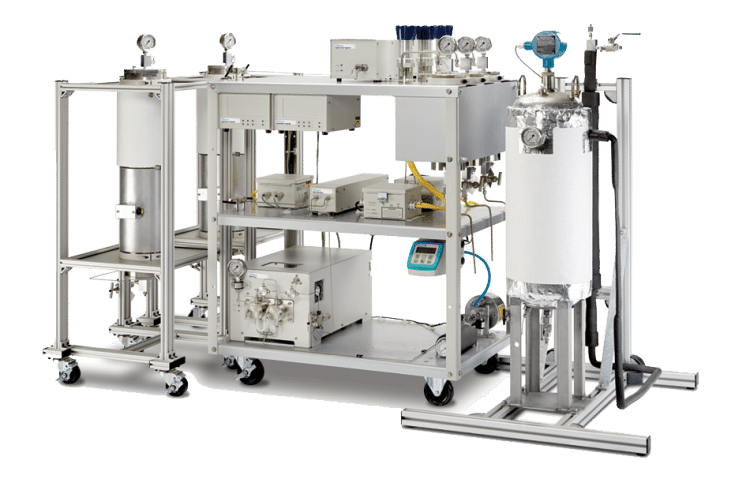Terpenes constitute the flavors and aromas of plants. In Cannabis, variation is typical for each chemovar. [1] Formed by head-to-tail condensed isoprene units, terpenes are classified depending on the content of carbon atoms (i.e., monoterpenes contain 10 C atoms, sesquiterpenes contain 15 C atoms, etc.). They possess relevant pharmacological properties [2-4], and they act in a synergistic way together with cannabinoids and other terpenes, mediating their effects and contributing to the “entourage effect.” [5]
Efforts have been made to improve terpene extraction from Cannabis. [6] The first obstacles to overcome are the thermal degradation and high volatility of this class of natural occurring compounds. In addition, their isolation is complicated by their relatively similar boiling points.
During a one-pot extraction with common solvents (i.e., alcohol, hexane, or butane), it is not possible to discriminate between terpenes and other Cannabis phytochemicals: post-processing procedures often result in a loss of more volatile monoterpenes, heat-promoted conversion of terpenes into each other, and an overall modification of the initial terpenes’ relative content.
Organic solvents may contaminate the final extract, being co-eluted with the terpene fraction during distillation. [6]
Supercritical fluid extraction (SFE) has been shown to be an effective method for Cannabis extraction and terpene isolation. Carbon dioxide (CO2) reaches the supercritical state at relatively low pressure and temperature (31 °C and 74 bar): at this stage it behaves as a fluid and a gas, bearing uncommon viscosity, density, and diffusivity, and reducing the denaturation of the extracted compounds. [7] Tuning the parameters of pressure and temperature, it is possible to selectively extract cannabinoids and terpenes and limit post-processing operations. [6]
The first step in the optimization of the terpene extraction process is to understand their solubility in CO2: loading a supercritical fluid chromatography instrument with a mixture of equal amounts of different terpenes, Kawka [6] illustrated that monoterpenes have high solubility at 70 bar and 50 °C. The SF extractor has to be equipped with a special collector chilled at -78 °C (with acetone and dry ice) in order to trap the more volatile monoterpenes. The flow rate for monoterpenes was set to 100 g/min.
Sesquiterpenes, higher in molecular weight than monoterpenes, were eluted together with cannabinoids in another vessel, and they can undergo post-processing operations without danger of denaturation. Sesquiterpenes eluted at higher pressure, temperature, and flow rate, namely 150 bar, 55º C, and 150 g/min. Finally, cannabinoids were extracted at 300 bar, 55º C, and 200 g/min. The gaseous state of CO2 at 25 °C and 1.013 bar allows an easy recovery of Cannabis phytochemicals leading to a solvent-free extract. [6]
References:
[1] Boot JK, Bohlmann J. Terpenes in Cannabis sativa – From plant genome to humans. Plant Science. 2019;284:67-72. doi:10.1016/j.plantsci.2019.03.022 [Times cited = 45 (Semantic Scholar), Journal impact factor = 3.591]
[2] Downer EJ. Anti-inflammatory potential of terpenes present in Cannabis sativa L. ACS Chem Neurosci. 2020;11(5):659-662. https://doi.org/10.1021/acschemneuro.0c00075 [Times cited = 4 (Semantic Scholar), Journal impact factor = 4.486]
[3] Paduch R, et al. Terpenes: substances useful in human healthcare. Archivum Immunologiae et Therapiae Experimentalis. 2007;55(315):315-327. 10.1007/s00005-007-0039-1 [Times cited = 236 (Semantic Scholar), Journal impact factor = 3.200]
[4] Andre CM, et al. Cannabis sativa: The plant of the thousand and one molecules. Frontiers in Plant Science. 2016;7(19):1–17. 10.3389/fpls.2016.00019. Times cited = 390 (Semantic Scholar), Journal impact factor = 4.407
[5] Hanuš LO, Hod Y. Terpenes/Terpenoids: Are they important? Medical Cannabis and Cannabinoids. 2020;3(1):25-60. 10.1159/000509733 [Times cited = 3 (Semantic Scholar)]
[6] Kawka E. A systematic approach to developing terpenes extraction conditions utilising supercritical carbon dioxide. 2018. https://www.chromatographytoday.com/article/supercritical-fluid-sfcgreen-chromatography/45/cattis-consulting/pa-systematic-approach-to-developing-terpene-extraction-conditions-utilising-supercritical-carbon-dioxidep/2337
[7] Budisa N, et al. Supercritical carbon dioxide and its potential as a life-sustaining solvent in a planetary environment. Life. 2014;4(3):331-340. 10.3390/life4030331 [Times cited = 43 (Semantic Scholar), Journal impact factor= 2.991]
Image: https://www.pngegg.com/en/png-tzpbi











